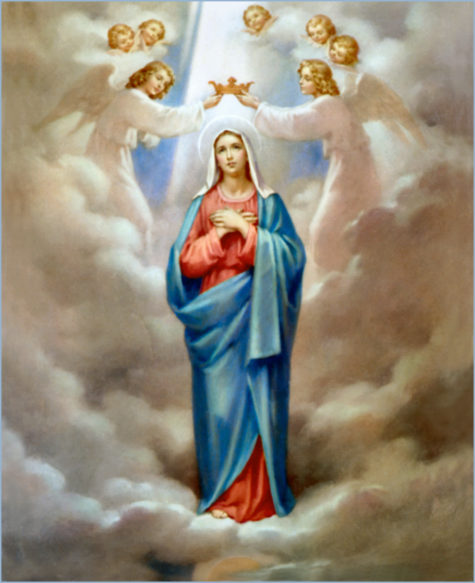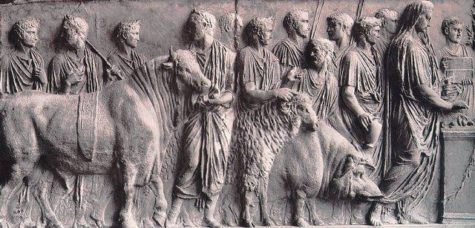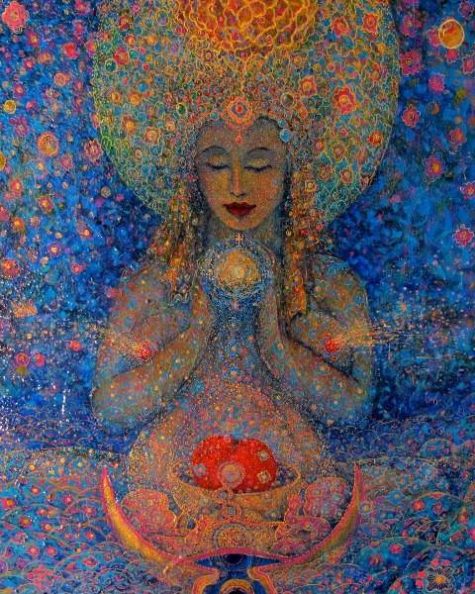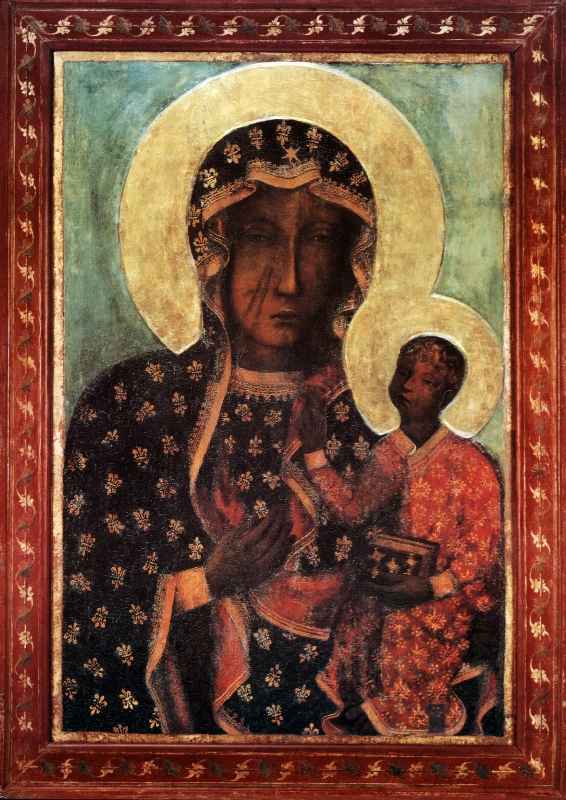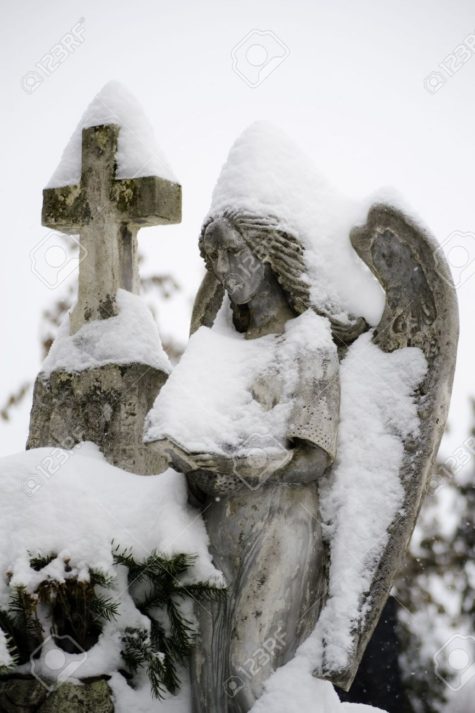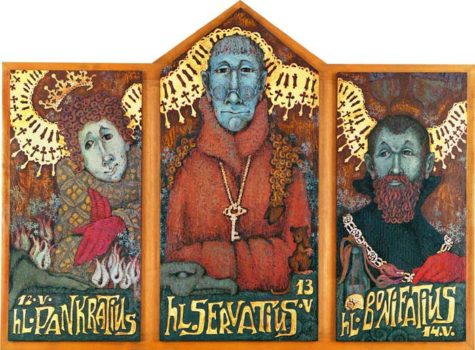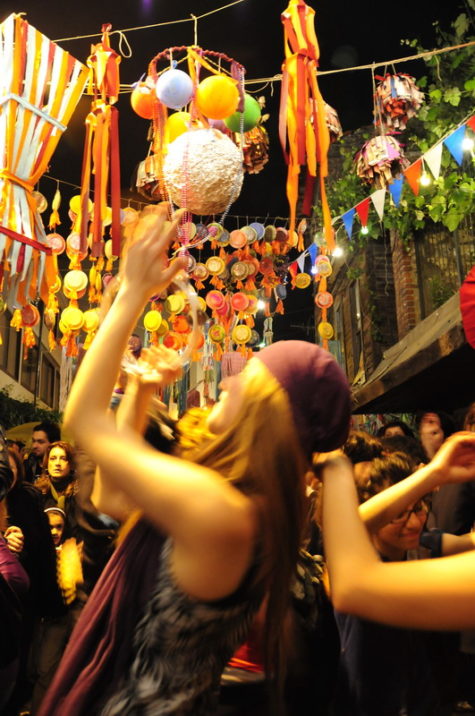Monthly Archives: May 2016
May 30 is celebrated as the Feast of the Queen of Heaven. Queen of Heaven, lovely goddess of May, fully grown and gloriously enthroned in pagan and Christian times. May honors the Blessed Virgin Mary, who is the modern-day Queen of Heaven, though somewhat demoted in status from her original divinity.
Have you noticed that it was always Mary who caused the miracles, who appeared to children – as at Lourdes and Fatima? the Queen of Heaven is a hard-working woman, and we light white candles to her. Praise active womanhood wherever you are and all will be well.
Calling upon the Queen of Heaven for aid in times of need is such a universal practice, that I can’t help but think it must be powerful and effective. If you’d like to try it for yourself, here is a prayer to Our Mother of Perpetual Help:
O Mother of Perpetual Help, grant that I may ever invoke Thy most powerful name, which is the safeguard of the living and the salvation of the dying.
O Purest Mary, O Sweetest Mary, let Thy name henceforth be ever on my lips. Delay not, O Blessed Lady, to help me whenever I call on Thee, for, in all my needs:
(name your request for help)
In all my temptations I shall never cease to call on Thee, ever repeating Thy sacred name, Mary, Mary
(again make your request for help).
O what consolation, what sweetness, what confidence, what emotion fills my soul when I pronounce Thy sacred name, or even only think of Thee. I thank God for having given Thee, for my good, so sweet, so powerful, so lovely a name. But I will not be content with merely pronouncing Thy name: let my love for Thee prompt me ever to hail Thee, Mother of Perpetual Help. Amen.
(Now recite nine Hail Marys)
From: The Grandmother of Time and other sources.
May 29 is the date given for the Roman festival of Ambarvalia, or the Corn Mother Festival. The Goddess Ceres, the food giver, now has her corn festival, which was the cause of a great deal of festivity. At these festivals they sacrificed a bull, a sow, and a sheep, which, before the sacrifice, were led in procession thrice around the fields. It is from this practice that the name Ambarvalia comes Ambio meaning I go round and Arvum meaning field.
These feasts were of two kinds, public and private. The private were solemnized by the masters of families, accompanied by their children and servants, in the villages and farms out of Rome. Celebrants gathered to walk around the freshly plowed fields in joyous processions, wearing crowns of oak leaves and singing hymns to the Earth.The public festivals were celebrated in the boundaries of the city, and in which twelve fratres arvales walked at the head of a procession of the citizens, who had lands and vineyards at Rome. During the procession, prayers would be made to the goddess.
Gods of our fathers, we purify the fields, we purify the farming folk.
O gods, drive evil outside our boundaries.
Let the crop not mock the harvest with deceiving grasses
nor the swift wolves scare the slower lamb.
~Tibullus
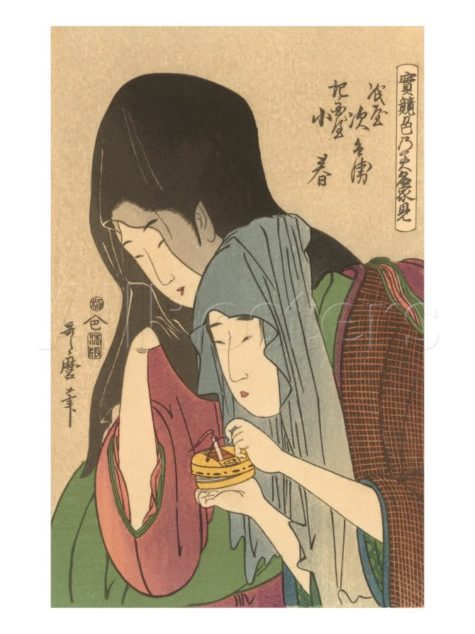 There is a festival in Japan on May 28 during which vendors sell insects in tiny bamboo cages. Those who purchase the diminutive pets keep them in or near the house during the summer months so that they can hear their songs in the evening. Then, on a day in late August or early September, they gather in public parks and at temples or shrines to set the insects free. When the creatures realize they have been released, the former captors listen to them burst into their individual sounds.
There is a festival in Japan on May 28 during which vendors sell insects in tiny bamboo cages. Those who purchase the diminutive pets keep them in or near the house during the summer months so that they can hear their songs in the evening. Then, on a day in late August or early September, they gather in public parks and at temples or shrines to set the insects free. When the creatures realize they have been released, the former captors listen to them burst into their individual sounds.
The custom of freeing the insects, also known as the Insect-Hearing Festival, is more common in the countryside. Although no one seems to know its exact origin, it is reminiscent of Italy’s Festa del Grillo, where crickets are purchased in cages and kept as good luck tokens or harbingers of spring.
A picturesque rite passed down from feudal days, this festival is held in temple and shrine precincts, public parks, and many gardens. People gather in these chosen spots where they take insects in tiny bamboo cages, some purchased from insect vendors for this ceremony, and set these insects free.
As part of the ceremony, the liberator waits for the insect to get its bearing, realize its freedom, then listen to it as it chirps.
Note: This post was put together by Shirley Twofeathers for Gypsy Magic, and moved to its new home here at shirleytwofeathers.com. You may repost and share it only if you give me credit and a link back to this website. Blessed be.
May 25 is the Chinese and Japanese Celebration of the Tao – The Mother of the World. In Taoism, a great spiritual tradition of the East, the Goddess is perceived as the mother of the world, the Way to the heart.
On this day, burn incense to the Goddess and meditate on Divine Harmony. The whole philosophy of the Way (or Tao) in Chinese mysticism is essentially a respect for the truth in nature and her ways. It is also a belief that people must live in harmony with the Way and not destroy or interfere but, rather, flow with it. This, as they say, is:
“Holding fast to the Mother. She is the origin of all things and beings, born before heaven and earth. Silent and void she stands alone, does not change, goes round and does not weary, and is capable of being the mother of the world.”
~Tao Teh Ching
From: The Grandmother of Time
The Mothers of Arles is a French festival that runs from May 24 through May 28. This unique festival celebrating the triple goddess is still alive and well in France, celebrated mostly by gypsies. The “Three Maries of the Sea” recall the ancient goddess of life, death, and beauty. The gypsies gather from all over Europe and carry on their annual celebrations of the triple goddess. Three women dressed up as Mare, Tavobe, and Mary impersonate the goddesses, reaching the shore in boats.
In modern times, Sarah and Salome are the companions of Mary in this trinity. Fancy processions, gypsy weddings, trading of all sorts, fortune-telling, the leaping of cows (a survival from the ancient practice of bull leaping), dancing gypsy style, and candles give these days and nights their wild beauty.
From: The Grandmother of Time
St Sara of Egypt is the Romanies’ patron saint. Throughout the eve of May 24 and during May 25th, Gypsies exalt the elements of fire and water. From wood the men have gathered, Gypsy women build a healthy campfire. They cook a huge feast and gather around the fire to exchange presents and good cheer.
On May 24th many Romanies still make a pilgrimage to attend an annual service at the shrine of St Sara of Egypt, in the crypt of the church of Les Saintes Maries de la Mer in the Ile de la Camargue, Bouches-du-Rhone, France. They carry the statue of St. Sara, who is black, into the sea (from where she originated) and out again.
From: The Good Spell Book
May 15 is the feast day of Saint Sophia of Rome. On this date, Saint Sophia was regularly invoked against frosts that occurred late in the year; thus she was called kalte Sophie ‘cold Sophia’ in Germany by those who requested her aid in planting arable crops. Considered to be one of the “Ice Saints”. Sophia is also an “ice saint” in Slovenia and Central Europe, where St. Sophia’s day (“Cold Sophie”) is considered the last day of cold weather. There, Sophia is associated with rain and is nicknamed poscana Zofka ‘pissing Sophie’ or mokra Zofija ‘wet Sophia’ in folk tradition. In Czech, the Sophia is known as “Žofie, ledová žena” (Sophia, the ice-woman).
Many of the old weather rules are now forgotten. Nowadays, we rely on the weather forecasts of radio and television. According to lore, the “Ice Saints” Pankratius, Servatius and Bonifatius as well as the “Cold Sophie” are known for a cooling trend in the weather between 12th and 15th of May. For centuries this well-known rule had many gardeners align their plantings after it. Observations of weather patterns over many years have shown, however, that a drop in temperature occurs frequently only around May 20. Are the “Ice Saints” not in tune anymore? The mystery solution is found in the history of our calendar system: Pope Gregory VIII arranged a calendar reform in 1582, whereby the differences of the Julian calendar could be corrected to the sun year to a large extent.
The day of the “Cold Sophie” (May 15) was the date in the old calendar and corresponds to today’s May 22. Therefore the effects of the “Ice Saints” is felt in the time span of May 19-22. Sensitive transplants should only be put in the garden beds after this date.
Who is Saint Sophia of Rome?
According to tradition, she was a young woman of Rome who was killed for her faith during the reign of Diocletian. She was buried in the cemetery of Gordianus and Epimachus, and is venerated by the catholic church as a Christian martyr.
Notes:
- Saint Sophia of Rome is not the same as Saint Sophia the Martyr
- Read more about the Ice Saints here: Three Chilly Saints
May 11, 12, and 13 are the feast days of Saints Mamertus, Pancras, and Gervais. These three are known as the Three Chilly Saints not because they were cold during their lifetimes, but because these days bring a brief spell of colder weather in many years, including the last nightly frosts of the spring, and are traditionally the coldest of the month.
English and French folklore (and later American) held that these days would bring a late frost. In Germany, they were called the Icemanner, or Icemen Days, and people believed it was never safe to plant until the Icemen were gone. Another bit of folklore claimed:
“Who shears his sheep before St. Gervatius’s Day loves more his wool than his sheep.”
In Sweden, the German legend of the ice saints has resulted in the belief that there are special “iron nights,” especially in the middle of June, which are susceptible to frost. The term “iron nights” (järnnätter) has probably arisen through a mistranslated German source, where the term “Eismänner” (ice men) was read as “Eisenmänner” (iron men) and their nights then termed “iron nights,” which then became shifted from May to June.
To the Poles, the trio are known collectively as zimni ogrodnicy (cold gardeners), and are followed by zimna Zośka (cold Sophias) on the feast day of St. Sophia which falls on May 15. In Czech, the three saints are collectively referred to as “ledoví muži” (ice-men or icy men), and Sophia is known as “Žofie, ledová žena” (Sophia, the ice-woman).
Alternative Saints:
St. Mamertus is not counted among the Ice Saints in certain countries (Southern Germany, Austria, Northern Italy, Czech Republic, etc.), whereas St. Boniface of Tarsus belongs to them in other countries (Flanders, Liguria, Czech Republic etc.) as well; St. Boniface’s feast day falling on May 14. St. Sophia, nicknamed Cold Sophia (German kalte Sophie) on May 15 can be added in Germany, Alsace (France). In Poland and the Czech Republic, the Ice Saints are St. Pancras, Saint Servatus and St. Boniface of Tarsus.
Related Content:
- A nice little spell, Ice Saint Toxic People Banishing Spell, can be found at The Book of Shadows
Note:
The introduction of the Gregorian Calendar in 1582 involved skipping 10 days in the calendar, so that the equivalent days from the climatic point of view became May 22–25.
Found at: Almanac.com and wikipedia
The ancient Romans celebrated the Lemuria on May 9, 11, and 13. During these times they honored the wandering ancestral and family spirits. Many modern people still make the trip to the cemetery during the Memorial Day weekend for the purpose of putting flowers on graves, a way of acknowledging and remembering deceased family members.
However, it is not necessary to go to cemeteries to honor your ancestors. In your long lineage, most of your ancestors will not have been buried near you, and some will have been cremated and their ashes scattered or their physical bodies lost. This day of remembrance is not to honor a decayed physical body, but to honor the bloodlines that led to your existence.
Set up a spot within your home as a temporary ancestor altar; choose a setting that will not be disturbed for at least a week. On this altar place what pictures you have of deceased family members. If you have no pictures, print out their names on a nice piece of paper. Arrange a small vase of fresh flowers near the pictures. Burn lavender or rose incense daily near this area.
Sometime during each day of this week, go to your remembrance altar and talk with your ancestors. Don’t forget to call upon the ones so far back in your lineage that you never met them. burn a white candle there for at least an hour each day.
Perhaps you have a few immediately deceased family members with whom you didn’t get along. Most people do. If you find their spirit energies causing problems (and some will do this), simply remove their pictures until they can behave themselves. This may sound silly, but it works on most spirits. They want to be remembered and acknowledged not put out of mind and sight.
Often those family members with whom there was the most friction will be of most help because they may want to make up for bad karma. Occasionally, a very few will be incorrigible and will have to be denied admittance to your home.
Each day, ask your ancestors for advice and help. If you meditate near this shrine, you may well find yourself visiting with loved ones. And remember to think about and call upon them throughout the rest of the year, especially at important occasions. You can light candles, or set extra places at the table for them during seasonal festivities such as birthdays, thanksgiving and Christmas.
From: Moon Magick
Đurđevdan is a major holiday for Roma from former Yugoslavia, whether Orthodox or Muslim. The various Balkan spellings (Herdeljez, Erdelezi) are variants of the Turkish Hıdırellez.
Ederlezi is the Gypsy name for the Bulgarian and Serbian Feast of Saint George. It’s celebrated on the 6th May, a holiday signaling the beginning of spring, occurring approximately 40 days after the spring equinox. This Spring festival is especially celebrated by Roma people around the former Yugoslavia (and elsewhere around the world), regardless of religious affiliation.
This holiday celebrates the return of springtime and is considered most important. The traditions of the Roma Durđevdan are based on decorating the home with flowers and blooming twigs as a welcoming to spring. It also includes taking baths added with flowers and washing hands with water from church wells. Also the walls of the home could be washed with the water. On the day of the feast it is most common to grill a lamb for the feast dinner. The appearance of music is also very important during this holiday. Aside from dancing and singing, traditional Brass bands are popular.
Đurđevdan in Serbian, Gergyovden in Bulgarian or Jurjevo in Croatian and Bosnian, “George’s day”, is a South-Slavic religious holiday, celebrated on April 23 by the Julian calendar (May 6 by Gregorian calendar). The feast of Saint George is attached to the tradition of celebrating the beginning of spring, and is a very important Orthodox Christian custom of honoring a family patron saint.
Saint George is one of the most important Christian saints in Orthodox churches. Christian tradition holds that St. George was a martyr who died for his faith. On icons, he is usually depicted as a man riding a horse and killing a dragon. Jurjevo is mainly celebrated in the rural areas of Croatia, mostly Turopolje and Gornja Stubica whereas every Đurđevdan is celebrated in many Serbian communities, but mainly in Serbia, Montenegro and Bosnia Herzegovina. In Croatian St. George is called Sv. Juraj while in Serbian he’s called Sveti Đorđe and in Bulgarian- Sveti Georgi.
In Croatia, the Catholic version of St.George’s day, Jurjevo is celebrated on April 23 by the Gregorian calendar. The tradition is mostly celebrated in northern Croatia, in Zagreb County. According to tradition this day marks the beginning of spring. The use of bonfires is similar to Walpurgis Night. In Turopolje, Jurjevo involves a slavic tradition where five most beautiful girls are picked to play as Dodola goddesses dressed in leaves and sing for the village every day till the end of the holiday.
Source: Wikipedia
See also: Ederlezi at Gypsy Magick and Lore
